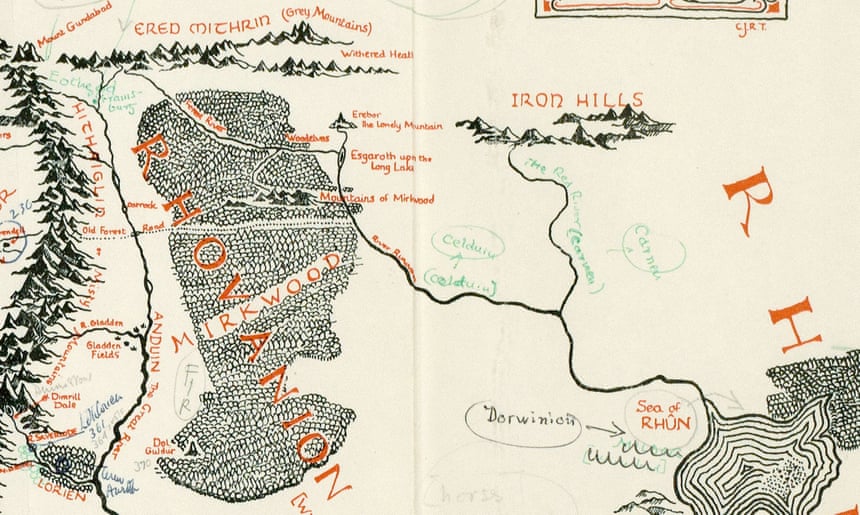Map goes on sale in Oxford for £60,000 after being found inside novel belonging to illustrator Pauline Baynes

A recently discovered map of Middle-earth annotated by JRR Tolkien reveals The Lord of the Rings authors observation that Hobbiton is on the same latitude as Oxford, and implies that the Italian city of Ravenna could be the inspiration behind the fictional city of Minas Tirith.
The map was found loose in a copy of the acclaimed illustrator Pauline Baynes copy of The Lord of the Rings. Baynes had removed the map from another edition of the novel as she began work on her own colour Map of Middle-earth for Tolkien, which would go on to be published by Allen & Unwin in 1970. Tolkien himself had then copiously annotated it in green ink and pencil, with Baynes adding her own notes to the document while she worked.
Blackwells, which is currently exhibiting the map in Oxford and selling it for 60,000, called it an important document, and perhaps the finest piece of Tolkien ephemera to emerge in the last 20 years at least.
It shows what Blackwells called the exacting nature of Tolkiens creative vision: he corrects place names, provides extra ones, and gives Baynes a host of suggestions about the maps various flora and fauna. Hobbiton, he notes, is assumed to be approx at latitude of Oxford; Tolkien was a professor of Anglo-Saxon at Oxford University.

The novelist also uses Belgrade, Cyprus, and Jerusalem as other reference points, and according to Blackwells suggests that the city of Ravenna is the inspiration behind Minas Tirith – a key location in the third book of the Lord of The Rings trilogy.
The map shows how completely obsessed he was with the details. Anyone else interfered at their peril, said Sian Wainwright at Blackwells. He was tricky to work with, but very rewarding in the end.
Correspondence between Tolkien and the late and acclaimed illustrator Baynes, who also worked on books for CS Lewis, as well as Bayness unpublished diary entries, gives further details about the sometimes thorny relationship between the two. On 21 August 1969, Baynes describes a visit to Tolkien and his wife in Bournemouth, to chat about a poster map I have to do he very uncooperative.
The author later apologies for having been so dilatory, and a later lunch sees the author in great form first names and kissing all round and pleased with the map.
Henry Gott, modern first editions specialist at Blackwells Rare Books, said the map was an exciting and important discovery: new to scholarship (though its existence is implied by correspondence between the two), it demonstrates the care exercised by both in their mapping of Tolkiens creative vision.
Before going on display in the shop this week, this had only ever been in private hands (Pauline Bayness for the majority of its existence). One of the points of interest is how much of a hand Tolkien had in the poster map; all of his suggestions, and there are many (the majority of the annotation on the map is his), are reflected in Bayness version, said Gott. The degree to which it is properly collaborative was not previously apparent, and couldnt be without a document like this. Its importance is mostly to do with the insight it gives into that process.
Blackwells is selling a range of works by Baynes, who died in 2008, aged 85, including a range of her original signed drawings from the Narnia books.
- This article was amended on 23 October 2015. The map was not found by a Blackwells Rare Books specialist, but found in a book handed into the shop. This has been corrected.
